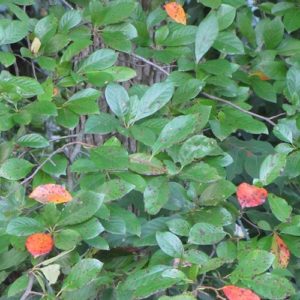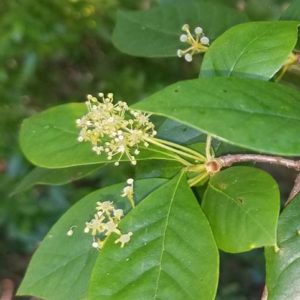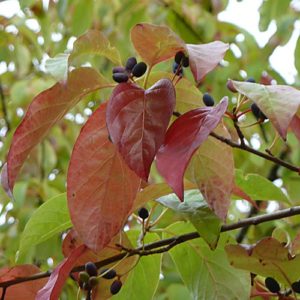Have you ever been walking in August or September and noticed a tree with a few scattered red leaves? You may have thought “that’s weird,” because obviously it is still way too early for the leaves to be turning colors. If so, you may have been looking at a black gum. Black gum is a tree that I think is worth getting to know for anyone in the eastern U.S. who is interested in native trees, pollinators, and wildlife.

Black Gum General Biology and Life History
Black gum (Nyssa sylvatica) is also commonly called blackgum, black tupelo, and sour gum. It is native to most of the eastern half of the U.S. and grows in a wide variety of soils. It can grow up to 100 feet tall, but 20-30 feet is more normal. Personally, I’ve never seen one anywhere close to 100 feet tall.
It is a very easy tree to overlook during most of the year, because the leaves look like generic leaves and the bark looks like generic bark. Visually, it just doesn’t really stand out as anything special, until the early fall. In Kentucky, I typically start seeing the first red leaves appear on black gum sometime in August. At first it is just a few scattered leaves, but eventually the whole tree will turn a brilliant, deep, scarlet red. One hypothesis for the early fall color is that it might help birds and other wildlife know that the fruits are starting to ripen.
Black gum flowers bloom in the late spring. In Kentucky, that usually means the May to June timeframe. The flowers form in clusters and are small, creamy white, and easy to overlook. Most trees will either produce mostly male flowers or mostly female flowers, but they both may have a few perfect flowers scattered throughout. (Perfect flowers have both male and female parts.) Only the female flowers and the perfect flowers will produce fruit. The fruits ripen in late summer or early fall and are a dark bluish-black, berry-like drupe that is approximately half an inch long.
Pollinator and Wildlife Uses of Black Gum
All kinds of bees are highly attracted to the flowers. In fact, both black gum and its close cousin the swamp tupelo (Nyssa aquatica) are considered honey trees in many areas. (Honey plants are species that produce enough nectar and are attractive enough that honey bees may gather enough nectar from the flowers to make harvestable amounts of honey in areas where that species is abundant.)

Black gum fruits are also highly nutritious and are sought after by a wide range of birds including turkeys, robins, woodpeckers, mockingbirds, brown thrashers, thrushes, flickers, and many others. It is sometimes cited as being an important food source for songbirds preparing for the fall migration. Small mammals that can get to the fruits will also devour them.
Young black gum seedlings and foliage are considered a preferred food source for deer. In areas where deer are extremely over populated, this can make it difficult to successfully grow black gums in more landscaped settings and can lead to it being almost eliminated from some wilder settings. However, as the tree matures, the foliage becomes less palatable to deer and they tend to leave it alone at that point.
As black gums get older, they will often develop heart rot and become hollow. However, their wood is very strong and they can remain standing and live for many, many years even if they are hollow. Once they become hollow, the trees develop even more value for wildlife. Owls and other cavity nesting birds, raccoons, bats, and a wide range of other animals will use the hollow trees for shelter. Historically, hollow black gum logs were also cut into sections and used to house honey bee colonies.
Incorporating Black Gum into Your Yard
Black gum has many characteristics that make it an excellent possibility for many yards or other landscaping situations. It tends to produce a single, straight trunk that has branches coming off at almost perfect angles to make the tree much less likely to split or have branches grow into each other and cause rot issues. This growth characteristic also makes it very aesthetically pleasing in landscaped situations. Black gum’s brilliant fall color adds to its aesthetic value.

Although black gum is native throughout most of the eastern U.S., how much fall color an individual plant displays and exactly when it occurs can vary. This is a species where it is definitely recommended to try and obtain a local genotype if at all possible. A black gum with southern genetics that is planted in more northern areas may not be as colorful as individuals with more local genetics. Most native plant nurseries don’t mind you asking where the genetic stock of the trees came from. I also recommend the straight, wild-type species, but if you don’t have a native plant nursery near you and can’t find the straight species, then there are cultivars available through the traditional horticulture trade.
Black gums love full sun, but can grow in part shade as well. It’s also not very picky about soils and can also grow in a wide range of soil types. Black gums make great specimen trees or shade trees. However, they can be slow growing and, like I mentioned before, young saplings and foliage are a preferred food source for deer. If you know you have a high deer population in your area, then you’ll need to protect the tree for its first few years. Since black gum can get fairly tall with a decently wide spread, you’ll also want to make sure you plant it away from power lines.
Summary
Black gum is an often-overlooked tree that can provide a lot of value for wildlife in both wilder areas and around our homes. Its early, scarlet red fall colors that appear before most other trees start to change color can also add an “ooh and aww” element to your yard. The berries can attract a wide range of songbirds, the flowers can help feed the bees, and later in life it can provide shelter for many cavity seeking animals.

Backyard Ecology: Exploring Nature in Your Backyard
Nature isn’t just “out there.” It’s all around us, including right outside our doors. Hi, my name is Shannon Trimboli, and I am the host of Backyard Ecology. I live in southcentral Kentucky and am a wildlife biologist, educator, author, beekeeper, and owner of a nursery specializing in plants for pollinators and wildlife conservation. I invite you to join me as we ignite our curiosity and natural wonder, explore our yards and communities, and improve our local pollinator and wildlife habitat. Learn more or subscribe to my email list at www.backyardecology.net.

Leave a Reply to Fran Peebles Cancel reply